Plant description
The Maidenhair Fern is a genus with over 250 varieties. Within the indoor plant community, this group of ferns is highly-priced for their small, delicate fan-shaped fronds clustered on shiny and curved black stems. Maidenhair Fern species are popular options as both a houseplant and, because of their hardiness to cold temperatures, as an outdoor plant – growing best in a shade garden or a thickly growing woodland garden.
Keeping a Maidenhair Fern indoors can sometimes be a challenge, requiring specific growing conditions like high levels of humidity and consistent, evenly moist soil. Although, find the right balance between moisture, soil, and sunlight, and this beautiful variety of ferns will reward you with deep-green growth, charmingly delicate leaves, and an aesthetic that is sure to liven up any living space.
Plant facts
| common name | Maidenhair Fern |
| botanical name | Adiantum spp. |
| no. of species | 200+ |
| family | Pteridaceae |
| biological life cycle | perennial |
| foliage | evergreen |
| mature size | 0.5 – 2 feet tall, 0.5 – 2 feet wide |
| time to maturity | 2-3 growing seasons |
| origin | North America, Tropical America (West Indies) |
| light conditions | indirect sun with partial shade |
| soil type | well-draining loam |
| soil pH | alkaline (7-8) |
| USDA Zone | 8-10 |
| toxicity | non-toxic to pets and humans |
Popular varieties
Northern Maidenhair Fern (Adiantum pedatum), Delta Maidenhair Fern (Adiantum raddianum), Western Maidenhair Fern (Adiantum aleuticum), Southern Maidenhair Fern (Adiantum capillus-veneris), and Rosy Maidenhair (Adiantum hispidulum).
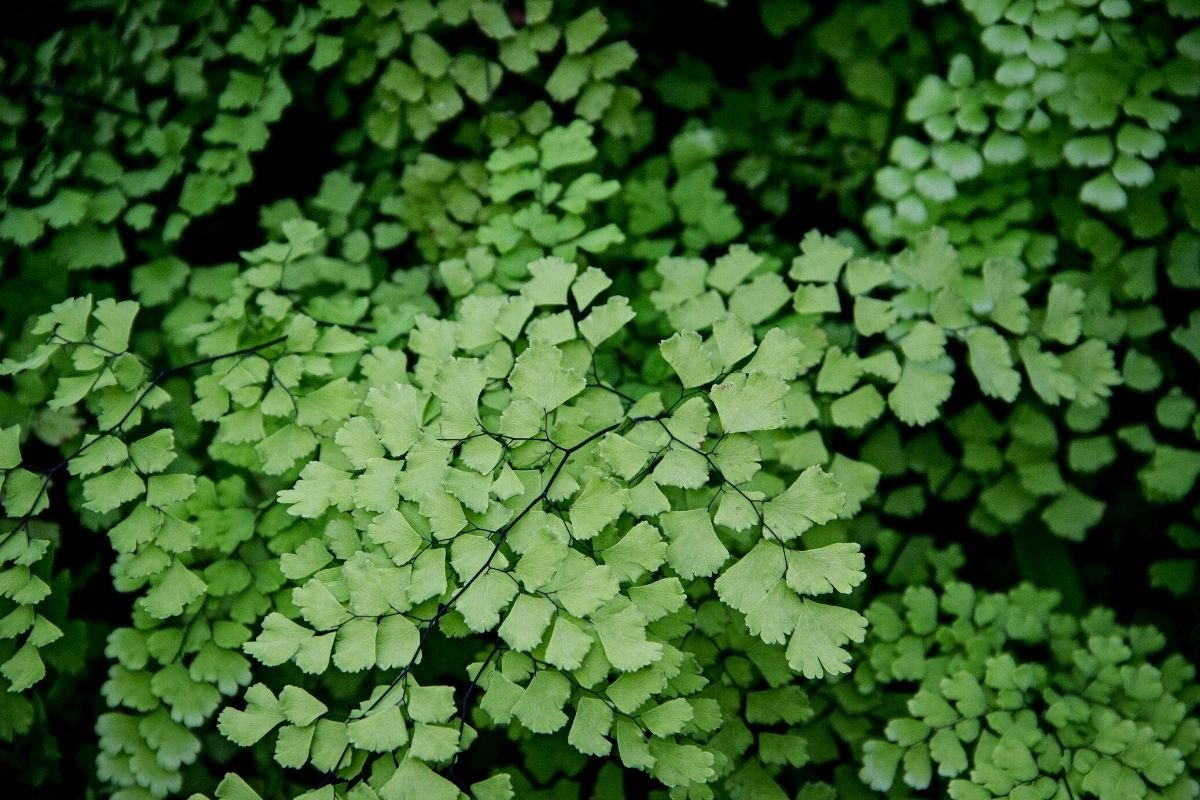
How to take care of a maidenhair fern
Light 🔆
Best light: indirect sun with partial shade
The Maidenhair Fern should be placed in bright indirect light to best imitate its natural environment, where it receives a bit of shade and a bit of direct light. It’s best to avoid harsh or direct sunlight as its delicate foliage can burn very easily.
Water 💧
Water needs: high, frequent watering
The Maidenhair fern requires frequent watering at levels that keep the growing medium moist but not saturated. It’s super important that the soil never completely dries out. With that in mind, check every day or every other day, and whenever the soil feels slightly dry it’s time for a sprinkle of water.
In addition to watering, misting the leaves frequently also helps keep the fern moist. In this context, a spray bottle works best. A spray bottle nozzle adjusted correctly will imitate the light, gentle rain, and small droplets these types of ferns would receive growing on the floor of a thick rainforest canopy.
Humidity 🌫️
As with most ferns, the Maidenhair thrives on moist air and high humidity. With dry air coming from vents in a home, it can be hard to maintain high humidity levels inside. Misting every day or using a water-filled pebble tray are both great ways to maintain the necessary humidity these types of indoor plants prefer.
If you’re not sure what the humidity is in your home to begin with, use a hygrometer to monitor the conditions in your home. For those with some type of humidity monitor, Maidenhair ferns are quite happy in relative humidity as low as 30 percent but will do much better at levels between 50-70%.
Temperature 🌡️
Different varieties of Maidenhair Ferns have evolved to suit different climates and, therefore, prefer different temperature ranges. For instance, the Southern Maidenhair or Adiantum capillus-veneris is native to California and the southern regions of the United States.
Because of this, it is quite comfortable in temperatures at around 10°C or 50°F. In the same breath, the very popular Delta Maidenhair or Adiantum raddianum will even tolerate temperatures as low as 5°C or 41°F.
Although, if you really want to get the most out of this cold tolerant variety of ferns, it’s best to keep them at temperatures of around 21°C or 70°F.
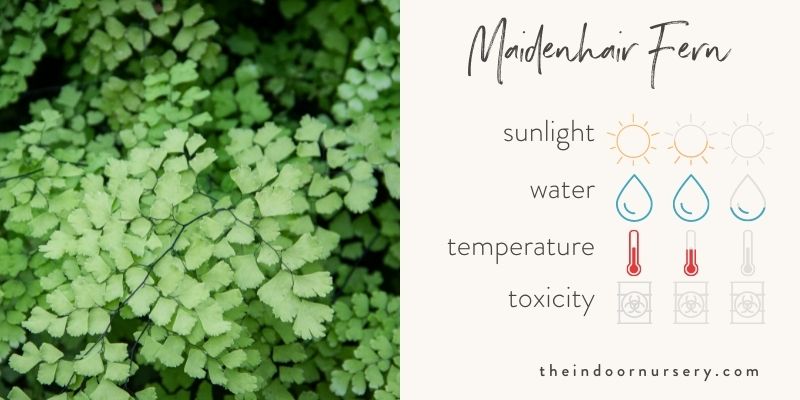
Fertilizer 💩
During the warmer growing season, fertilize your Maidenhair fern monthly with a diluted liquid fertilizer blend, per the manufacturer’s instructions. Over the winter months, fertilization can be halted altogether as growth will be very slow or non-existent.
Avoid using too much fertilizer as it can cause the tips of the sensitive leaves. If your Maidenhair shows signs of over-fertilization, give the growing medium a good flush with filtered water. This will wash out any excess fertilizer and relief the roots of becoming further inundated with unwanted macro and micronutrients.
Soil
A moist and well-draining soil is essential for a healthy Maidenhair fern. One option is a homemade potting mix of 1 part loamy potting mix, 1 part organic matter (such as compost), and 1 part peat or coconut coir.
Adding organic matter to the soil helps to retain water and create a humus-rich environment. Peat helps to release soil moisture to plant roots when needed. While loam holds nutrients for feeding and has a texture that retains water long enough for plant roots to access it. Yet, it is well-draining enough to allow water to flow from roots, which is essential for preventing root rot.
Unlike many other plants, Maidenhair Ferns enjoy an alkaline soil of between 7-8. At these levels, a Maidenhair Fern will have access to optimal levels of its preferred nutrients and thank you with beautiful green growth and luscious full fronds.
- Soil Type: Loam
- pH level: Alkaline between 7-8
Repotting
The Maidenhair fern can be repotted annually or biannually. It is best done when the roots become a little crowded but before root-bound sets in. To repot, very carefully run a blunt knife or spade around the inner edge of the pot. This will help loosen up the soil and detach any stubborn roots that may have attached themselves to the inside of the container.
Now, turn the pot upside down and with one hand thread your fingers through the fern’s thick growth cupping the soil and stopping it from spilling everywhere. With the other hand, gently tap the bottom of the pot until the fern becomes loose and falls out.
Once the fern is out of its growing container, very gently spread its roots out with your fingers and separate any trouble areas that are root-bound. If you wish, divide any clumps of fern into singular plants and plant them in their own containers. Or, simply whack the entire plant back into a fresh batch of potting mix and, if needed, a larger-sized pot.
Propagation 🌱
Maidenhair Ferns should be propagated in warmer months, such as early spring. To start, use a spade, knife, or your hands to split the root ball into pieces with at least 2-3 fronds each. Plant each section in its own pot, and make sure it isn’t too large for the new size of the root. Each new pot should be watered well, and do not fertilize right away to avoid burning roots and leaves.

Pruning 🌿
Regularly maintained trimming and removing browned leaves at soil level can help to grow denser foliage and fronds. Although, some people do quite enjoy the brown colors a dying or dead frond adds between the mass of dark-green leaves. If you are one of these people, understand that pruning is a preference for this type of fern and certainly isn’t necessary to the overall health of the plant.
Pests and diseases 🐛
Pests: can be susceptible to mealybugs and scale
The Maidenhair Fern plant does not frequently attract pests, but common pest problems such as mealybugs, aphids, or scale are possible. If your indoor fern does happen to contract one of these pests, the use of insecticidal soap should help to clear this problem away easily. Although, prior to applying to the entirety of the plant, first, apply to a small area just to be sure you don’t harm its sensitive leaves.
Plant care tips
- To maintain higher humidity levels, avoid using a terracotta or clay pot. It’s best to keep the fern in its original plastic pot container with drainage holes and then place it in a larger decorative pot.
- To avoid dry air, placing ferns in bathrooms or near humidifiers is a great indoor moisture-rich environment option.
- Growing Maidenhair Fern species outside is also a popular option in addition to growing indoors. To grow outside, keep in mind the recommended USDA zone for most Maidenhair ferns is 8-10.
- To ensure proper water levels and maintain moist soil, a self-watering pot is a great option. A self-watering pot will also come in handy when you head off on vacation, ensuring water is kept at an adequate level.
Common Problems / FAQs:
Brown leaves, leaves curling up, leaf tips are dry, or leaves are falling off frequently
Answer: It’s possible the air is too dry and your Maidenhair Fern is in need of more moisture. To remedy this, water and mist the fern more frequently.
Yellowing fronds or poor growth
Answer: It’s possible the fern isn’t receiving enough light. Try moving it into a slightly brighter yet indirect lighting location.
Shop our recommendations
- The Best Hydroponic Tower For Indoor Gardening
- 10 Best Worm Composter Bins For Easy Homemade Compost
- The Best pH Meter For Soil
- The 6 Best Dehumidifiers For Grow Tents
- The Best Complete Indoor Hydroponic Grow System
- 5 Best Grow Light Strips For Indoor Plants
- TESTED: Aerogarden vs Click and Grow Smart Garden
- Our *hands on* MARS HYDRO TSW 2000 review (with photos)
- 7 Best Hygrometers For Indoor Plants
- The Best Coco Coir For Your Plant’s Healthiest Root System Ever

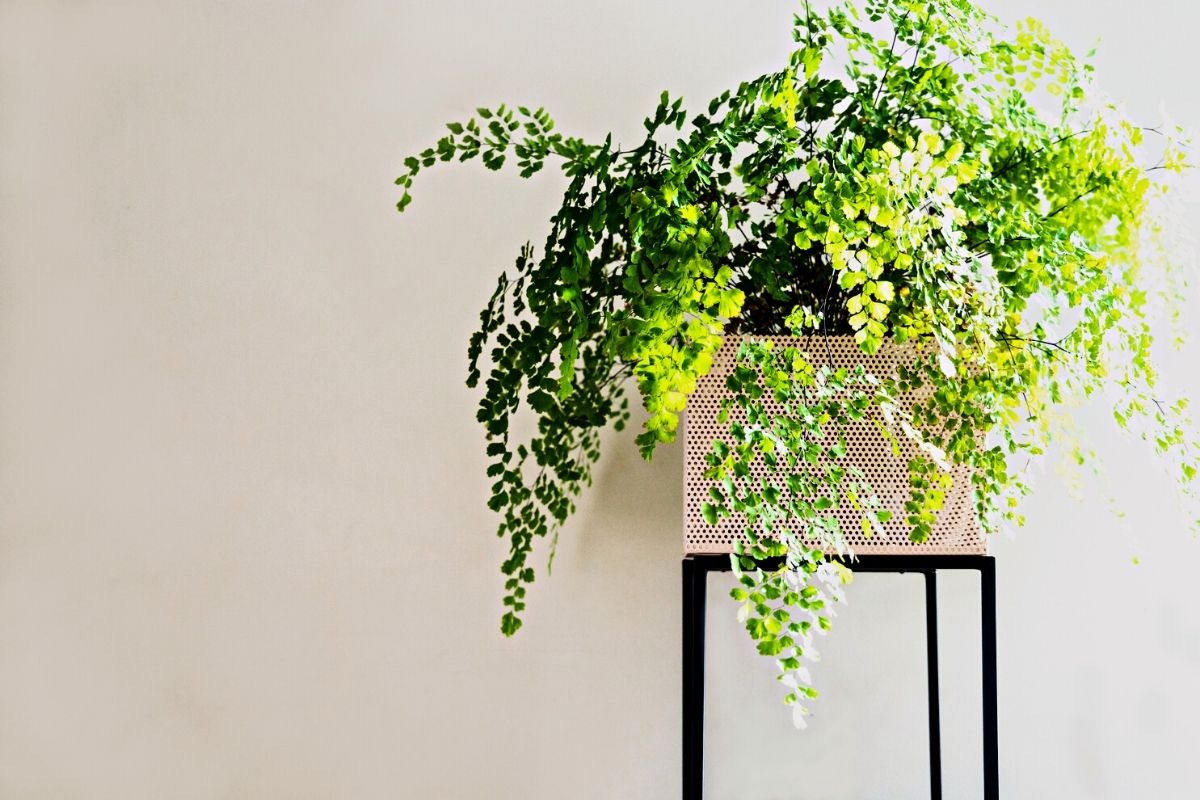
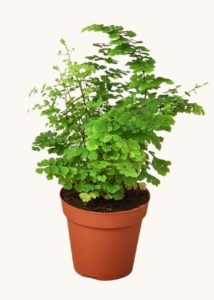





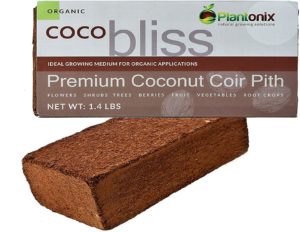

Hey, Marcia! Thanks for reading :) gosh, that's a great idea to double up on your watering globe and spike.…